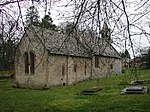Hampen Railway Cutting
CotswoldsEnglish Site of Special Scientific Interest stubsSites of Special Scientific Interest in GloucestershireSites of Special Scientific Interest notified in 1974
Hampen Railway Cutting (grid reference SP062205) is a 3.9-hectare (9.6-acre) geological Site of Special Scientific Interest in Gloucestershire, notified in 1974. The site is listed in the 'Cotswold District' Local Plan 2001-2011 (on line) as a Key Wildlife Site (KWS) and Regionally Important Geological Site (RIGS).
Excerpt from the Wikipedia article Hampen Railway Cutting (License: CC BY-SA 3.0, Authors).Hampen Railway Cutting
A436, Cotswold District Sevenhampton
Geographical coordinates (GPS) Address External links Nearby Places Show on map
Geographical coordinates (GPS)
| Latitude | Longitude |
|---|---|
| N 51.883477 ° | E -1.910604 ° |
Address
Hampen Railway Cutting
A436
GL54 5RJ Cotswold District, Sevenhampton
England, United Kingdom
Open on Google Maps








